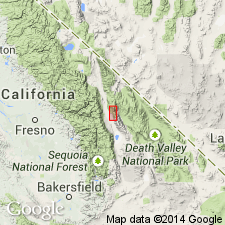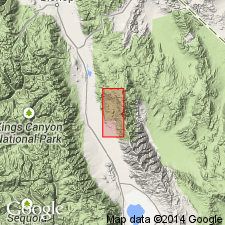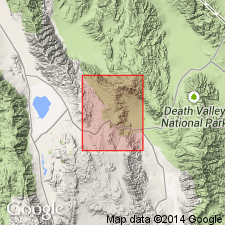
- Usage in publication:
-
- Al Rose Formation*
- Modifications:
-
- Original reference
- Biostratigraphic dating
- Dominant lithology:
-
- Siltstone
- Limestone
- AAPG geologic province:
-
- Great Basin province
Summary:
Pg. B75 (fig. 21.1), B79-B8O. Al Rose Formation of Mazourka Group. Distinctive orange- and red-brown-weathering, very thin irregular bedded siltstone, mudstone, shale, and some chert. Thickness not accurately determined due to faulting and folding. At type section is about 400 feet thick. Is readily distinguishable from overlying and underlying gray-weathering carbonate units. In places, contains lenses of less resistant, silty, medium-gray to bluish-gray limestone that weather back as holes, or "eyes." Underlies Badger Flat Limestone (new); top defined as uppermost occurrence of brown-weathering beds. Probably lies conformably on Tamarack Canyon Dolomite (new); base defined as lowest occurrence of fine-grained clastics and limestone, below which is thin- to thick-bedded dolomite. Previously called lower member of Mazourka Group (Phleger, 1933). Fossils (graptolites DIDYMOGRAPTUS PROTOBIFIDUS Elles and PHYLLOGRAPTUS sp. from near top, trilobites and phosphatic brachiopods from near base; identified by R.J. Ross, Jr., USGS) suggest possible correlation with Ninemile Formation and Goodwin Limestone of Pogonip Group. Age is considered Early Ordovician (Arenig).
Type Section: on a spur along east wall of Mazourka Canyon. Top of composite section (Al Rose and Badger Flat) is 6,000 ft S. 70 deg. E. from southeast corner sec. 36, T. 11 S., R. 35 E., Inyo Co., eastern CA. Named from exposures east of Al Rose Canyon, a tributary to Mazourka Canyon, Inyo Mountains, Independence 15-min quadrangle, Inyo Co., CA.
Formation crops out as a relatively continuous but faulted belt along almost entire length of Independence quadrangle. To north belt continues about 1 mile into adjacent Waucoba Mountain quadrangle, where it is cut out by Mesozoic granitic rocks and overlapped by Cenozoic deposits of Owens Valley. Southward belt of outcrop is interrupted by Mesozoic granitic plutons, but Al Rose lithology is recognized at several places along front of Inyo Mountains east of Lone Pine, New York Butte 15-min quadrangle.
Source: Publication; US geologic names lexicon (USGS Bull. 1350, p. 20-21); GNU records (USGS DDS-6; Menlo GNULEX).

- Usage in publication:
-
- Al Rose Formaton*
- Modifications:
-
- Mapped
- Biostratigraphic dating
- AAPG geologic province:
-
- Great Basin province
Summary:
Pg. 6, 9, 10-12, 44 (measured type section), pl. 1 (geologic map), pl. 2 (columnar section). Al Rose Formation of Mazourka Group. Distinctive orange- and red-brown-weathering, very thin irregular bedded siltstone, mudstone, and shale. Contains some chert, and in places, lenses of silty, medium-gray to bluish-gray limestone that weather back as holes, or "eyes." Thickness not accurately determined due to faulting and folding. Is 400(?) feet thick at type section. Probably lies conformably on Tamarack Canyon Dolomite. Fossils [listed]. Age is Early Ordovician. Report includes geologic map, columnar section, measured sections.
The following identifications and correlations furnished by R.J. Ross, Jr., USGS (USGS fossil locs. D811-CO, D915- to D920-CO, D1054-CO):
Graptolites (DIDYMOGRAPTUS PROTOBIFIDUS Elles, PHYLLOGRAPTUS cf. P. ILICIFOLIUS Hall, and P. ANNA Hall) collected from near top of formation indicate a late Arenig age, zones 4 and 5 of Elles (1925), and probably correlative with trilobite zone "J" of Garden City Formation, northeastern Utah (R.J. Ross, 1951, Yale Peabody Mus. Nat. Hist. Bull., no. 6) and with Ninemile Formation.
Trilobite TRIGONOCERCA? sp., collected from middle part of formation tentatively correlated with his zone "H" (Ross, 1951, p. 28) of Garden City and lower beds of Ninemile at its type section, and SHUMARDIA sp., collected from lower part of formation tentatively correlated with part of Goodwin Limestone of Eureka area, Nevada.
Source: Publication.

- Usage in publication:
-
- Al Rose Formation*
- Modifications:
-
- Areal extent
- AAPG geologic province:
-
- Great Basin province
Summary:
Unit geographically extended into area of report in Talc City Hills. Previously mapped as unit c of Pogonip Group by Hall and MacKevet (1962). Age is Early Ordovician.
Source: GNU records (USGS DDS-6; Menlo GNULEX).
For more information, please contact Nancy Stamm, Geologic Names Committee Secretary.
Asterisk (*) indicates published by U.S. Geological Survey authors.
"No current usage" (†) implies that a name has been abandoned or has fallen into disuse. Former usage and, if known, replacement name given in parentheses ( ).
Slash (/) indicates name conflicts with nomenclatural guidelines (CSN, 1933; ACSN, 1961, 1970; NACSN, 1983, 2005, 2021). May be explained within brackets ([ ]).

